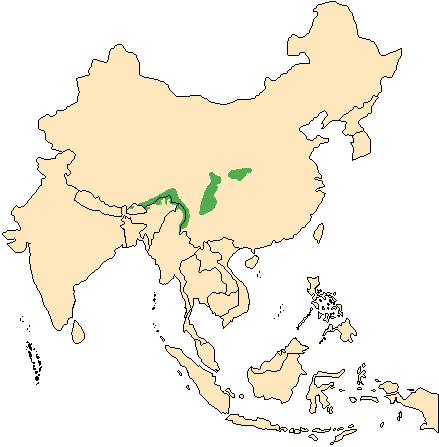![]() Return
to Artiodactyla
Return
to Artiodactyla
Classification
|
 Budorcas
taxicolor
Budorcas
taxicolor
Takin
![]()
Taxonomy
 |
 |
 |
Click on the pictures above for a larger view of the
photographs
|
||
General Characteristics
Body Length: 170-220 cm / 5.6-7.3 ft.
Shoulder Height: 100-130 cm / 3.3-4.3 ft.
Tail Length: 15-20 cm / 6-8in.
Weight: Up to 350 kg / 790 lb.The plump, bovine-like body is covered with dense, long yellow to brown hair. The short, stocky legs have broad hoofs and strong dew claws as an adaptation to their mountainous environment. In profile, the face is convex with the nasal ridge arching outwards. Both sexes carry strong horns that are 25-30 cm / 10-12 inches long, and curve out, backwards, and upwards at the tips. The bases of the horns may have transverse ridges.
Ontogeny and Reproduction
Gestation Period: 7-8 months.
Young per Birth: 1, rarely 2
Weaning: 9 months.
Sexual Maturity: At 2.5 years.
Life span: 12-15 years.
Ecology and Behavior
Takin feed the early morning and late afternoon, although on overcast days they may remain active throughout the day. Takin use narrow trails through the dense growth, which they regularly pass through in traveling between feeding and resting places. When threatened, they retreat into dense bamboo thickets, where they lie down. Adult bulls have been recorded pressing their bodies close to the ground with their necks stretched out in a very successful use of camouflage. The alarm call resembles a cough, and when uttered from one member of a herd, causes the whole group to flee.Family group: Small mixed herds in winter, herds of over 100 have been seen in summer, old males often solitary.
Diet: Grasses, leaves, buds, shoots.
Main Predators: Bears, wolf.
Distribution
Mountainous regions in the Himalayan Mountains and western China at an altitude of 1,950-4,500 m / 6,500-15,000 ft.

Range Map (Compiled from Shackleton, 1997)
Conservation Status
The takin as a species is considered vulnerable by the IUCN (1996). However, each subspecies has its own ranking: B. t. bedfordi - endangered; B. t. taxicolor - endangered; B. t. tibetana - vulnerable; and B. t. whitei - vulnerable.
Remarks
Takin is a Tibeto-Burman name for this animal. Bu (Greek) an ox; dorkas (Greek) a gazelle, a gazelle-like ox. Taxus (New Latin) a badger; color (Latin) colour, badger-coloured: a yellowish-gray.
Literature Cited
Nowak, R. M. [editor]. 1991. Walker's Mammals of the World (Fifth Edition). Baltimore: The Johns Hopkins University Press.Shackleton, D. M. [Editor] and the IUCN/SSC Caprinae Specialist Group. 1997. Wild Sheep and Goats and their Relatives. Status Survey and Action Plan for Caprinae. IUCN: Gland, Switzerland and Cambridge, UK.
Walther, F. R. 1990. Takins (Genus Budorcas). In Grzimek's Encyclopedia of Mammals. Edited by S. P. Parker. New York: McGraw-Hill. Volume 5, pp. 507-509.
Wilson, D. E., and D. M. Reeder [editors]. 1993. Mammal Species of the World (Second Edition). Washington: Smithsonian Institution Press. Available online at http://nmnhwww.si.edu/msw/
Return to Artiodactyla

![]()
© Brent Huffman, www.ultimateungulate.com |
|
|